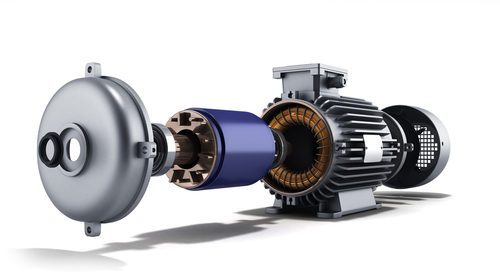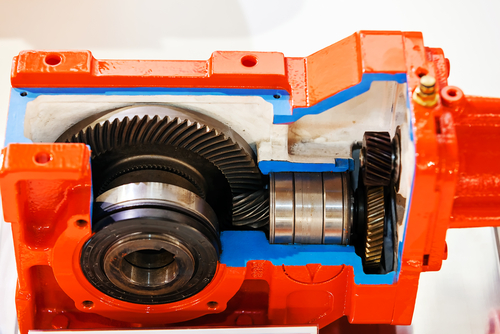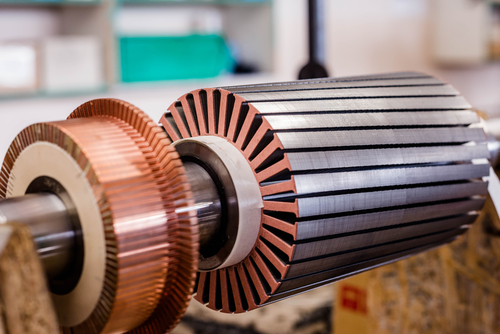Improved Efficiency Applications
Industrial electric motors removed the animal and hydraulic power in processing grain and pumping water. The electrical motor replaced the steam engines for powering steamships, locomotives, and industrial plants. Now, the Department of Energy estimates that electric motors have half of the country's electric power grid.
Electric motors play a vital role in business, businesses, and houses in the 21st Century. Increasingly, a drive for more green, eco-friendly technology has made change and innovation into the simple electric motor. Each motor has a particular application. Basic motors are classified into three different types: A.C. motor, D.C. motor, and technical motors.
A.C. Motor Basics
A.C. motors include both the synchronous motor and the induction motor. The easy electric motor role remains similar. Synchronous motors are used for both automation and robots. The validity of the synchronous motor stays high.
The induction engine uses electromagnetic induction. The induction engine's main features include low cost, small maintenance, higher dependability, and solid structure. Induction motors are used for residential, commercial, and industrial environments. An induction motor may be used for:
- Drilling machines
- Mixers
- Toys
- Pumps
- Compressors
- Vacuum cleaners
- Small fans
D.C. Motors
DC motor types comprise PMDC motors, compound wound, Shunt, and Series motors. The DC shunt motors are used for weaving machines, lifts, lathe machines, and industrial tools. Some DC Series Motors has a few disadvantages, restricting use. They work for small electrical appliances, hoists, and winches. Additionally, there are other applications for portable electric equipment. Call our electrical motor specialists now about which D.C. motor will meet your requirements.
Special Purpose Motors
Special purpose motors such as the linear servo motor or induction motor have different applications than the A.C. engine or the D.C. motor. The stepper motor has used, such as:
- Plotters
- Circuit Fabrication
- Usual Movement Generators
- Process Control tools
The brushless D.C. motor has better performance than the brushed D.C. motors but has less functionality than A.C. motors. Other technical motors comprise the Hysteresis Motor, the Reluctance Motor, and the Universal Motor. Each serves a particular purpose.
Benefits of A.C. and D.C. Motors
The DC motor is utilized for heavy-duty applications requiring high starting torque and streamlined design for high speed. A.C. motors are generally found where precise controllers have to boost efficiency and power output. This is where the controller technology has progressed most appreciably in the last twenty years.

Applications for Industrial Electric Motors
1 hp to 100,000 hp electric motors are available to meet any industrial need. Asynchronous and synchronous generators and motors are available to suit technical functions. The NEMA Frame is particularly suited to challenge environments. Additionally, the motors can be vertical with higher torque availability for extra power. Needless to say, they could operate on A.C. or D.C. power.
Examples of applications include industrial fans, pumps and blowers, machine tools, tanks, power tools, compressors, ships, roll mills, alternators, paper mills, movers, and other specific applications. Some systems can work in highly corrosive environments such as nuclear power stations and extremely aggressive environments like corrosive gases and chemicals. There's an electrical motor to meet just about any need.
Components of Industrial Electric Motors
Turning electricity into mechanical energy is the work of the industrial electrical motor. Motors create either a rotary or linear force. While electrical motors can be powered by direct current (D.C.) sources such as batteries, they're more frequently powered by alternating current (A.C.) sources such as generators or the electricity grid. Listed below are the main components of industrial electric motors:
Armature
This engine's moving part is that the armature (or rotor) rotates the shaft to convert the energy into mechanical power. Normally, the armature has conductors that carry currents that interact with the stator's magnetic field to produce a force that turns the shaft. The majority of the time, the armature is in the motor's center and rotates when the poles are attracted and repelled from the stator's poles.
Stator
The torque or strength of the engine is determined by the length of this electromagnet's cable in the stator in addition to the voltage. As the central portion of the electromagnetic circuit, the stator's core includes thin metal sheets to decrease energy use. The state may have permanent windings or magnets.
Air Gap
One important element is the air gap between the stator and rotor, which raises the magnetizing current. The distance of the air gap is a must in determining the performance. Usually, the air gap should be as little as possible.
Winding or "Coil"
Windings are wires wrapped around a center, usually, a soft iron magnet used to make or get the electromagnetic energy. The windings' cable must be coated and is usually copper as it conducts electricity with the thinnest wire. Aluminum can be used, though it must be thicker.
Commutator
This is the shifting mechanism that creates the reversal of electrical current and applies power to the machine since the rotor turns from pole to pole. With no current reversal, an engine would stop. The commutator is usually made of slip ring segments insulated from each other and the engine's shaft. Brushes or another mechanism is used to shift present.

New Motor Technologies Boost System Efficiency
Electric motors in United States industrial applications account for over 60 percent of energy use; even little efficiency improvements can significantly differ in energy savings. Two new motor technologies now available commercially provide breakthrough efficiency and reliability opportunities for the industry.
Copper Rotor Motor Is "Ultra-Efficient"
A brand new line of motors comprising the copper rotor motor technology has entered the U.S. industrial marketplace, providing substantial energy savings potential for manufacturers. Siemens Energy & Automation's induction A.C. motors have die-cast rotors that offer lower operating temperature, increased electric energy efficiency, extended motor life, and decreased size and weight. In actuality, those ultra-efficient motor designs have complete losses of 6.6 to 15.5 % below similar NEMA Premium efficiency motors while surpassing the NEMA Premium full-load performance standards by around 1.4 percent.
The die-cast copper cable engine technology results from many years of research and development from both the Copper Development Association Inc.(CDA) and Siemens to attain superior efficiency by replacing copper for aluminum in the squirrel cage induction engine.
CDA led the design of manufacturing processes and high-temperature mold materials to empower copper rotor motors' cost-effective production. The Siemens project team developed design procedures and managed a comprehensive modeling program to maximize the copper rotor engine's high conductivity. The result is a motor technology that provides high efficiency, functionality, and reliability.
According to the CDA, in the USA alone, a 1 percent increase in engine efficiency could save 20 billion kilowatt-hours (kWh) annually, or $1.4 billion in power (at 7 cents per kWh).
Siemens was instrumental in bringing the technology to the industrial market. The business incorporated the high-conductivity copper rotors in their motors, including aluminum and cast-iron frame versions.
Other improvements include low-friction bearings, a redesigned cooling system, dynamically balanced rotors, polyurea-based grease, and precision-machined mating surfaces limited vibration. Specially designed insulation lets use with variable speed drives. The new line of motors can be obtained around 20 horsepower.

Motor Controller Increases Efficiency and Improves Comfort
New techs for variable speed controllers of single-phase A.C. Induction engines in HVAC fan units provide an affordable, weatherproof solution for noise reduction and indoor climate comfort. The Adaptive Climate Controller uses several closed-loop signs, analog optical-based control, and sensor input to provide climate and moisture management, healthful air quality, and proven electricity savings of 30 to 50 percent.
Opto Generic Devices (OGD) Inc. made an optical programmable encoder and control combination that offers:
- Continually adaptive/variable speed
- Optimized commutation
- Dynamic vector control
- Real-time feedback
- Application tuning
- Signal enhancement for operating A.C. motors
OGD V-HVAC, OGD's subsidiary, developed the Adaptive Climate Controller (ACC) based on this technology. This exceptional technology is an alternative to electronic controllers, which may be complex, costly, and cause motors to run hot and create sound. This intelligent and flexible control maintains the human comfort zone's temperature by gently mixing room air based on space's demands. By slowly ramping up fan speeds, energy is conserved by utilizing only the electric and thermal energy required to fulfill the demand. Moreover, noise from electric, engine, and airflow is decreased.
The ACC technology has been commercialized in 2005 and has sold over 2,500 units. Projected yearly energy savings in the tech is 2.9 million Btu of electricity per 5,000 units.
